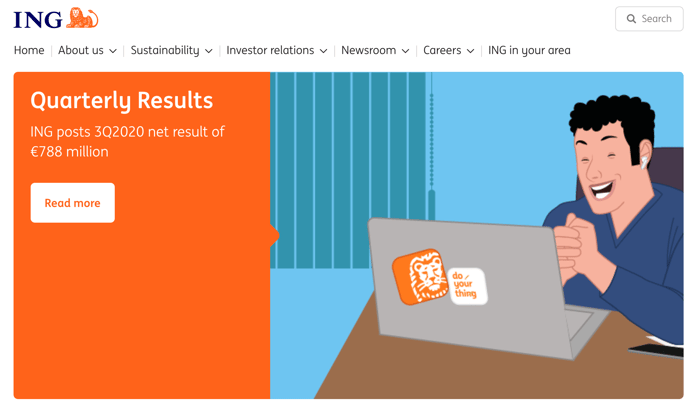How to Do Digital Transformation as a Large Company – Case Studies

That’s what makes digital transformation a challenge for the big players: understanding that to transform digitally they might need to start with small changes, such as making teams more agile to enable accelerated reactions to changes in the market. The digital transformation process might not involve fireworks in its early stages, but the organizational changes will bring measurable effects down the road.
Even the most traditional organizations can successfully transform into more innovative entities – especially when they embrace doing it from the inside and truly change their core. It’s often not a straightforward or easy process, but it’s definitely worth going through since it’s helping enterprises all over the world to stay or become competitive, making them more efficient and increasing their profits. With digital transformation, they can expect reliable growth and be ready to face new challenges with confidence.
Here are two companies and one innovative city-state that are excelling in digital transformation, each on its own terms.
Anheuser-Bush InBev – bring it up to the Cloud

AB InBev is a mega-brand which has acquired some of the world’s oldest and best renowned beer brands. Leffe, to take just one example, was originally brewed by Belgian monks 800 years ago – that is a couple hundred years before the invention of the printing press, world-changing technology of the middle ages. How do you manage a portfolio of traditional entities like this and successfully bring them together into the new digital reality?
The Belgium-based giant bet heavily on investment in their infrastructure and logistics. That’s where efficiency really reduces costs for the company – making the supply chain more efficient by even 1% can increase profit margins by millions of dollars.
Their supply chain is huge and complex. From sourcing the ingredients for the beers to getting the final product to the customers, the production and distribution must happen in a timely manner. If the process gets disrupted at any stage, it can cripple the sales. The opposite, the company overproducing a product with a short shelf-life, will also result in losses. So it is crucial for the brewer to precisely match the supply with the demand.
To improve and centralize the process, AB InBev needed to integrate many different systems that they inherited through numerous mergers and acquisitions. They decided to take their fragmented data directly to the cloud. The process is not a quick one, as the older systems are harder to update. A year and the half into the digital transformation, the company has managed to transition 40 percent of its workloads to the cloud.
Now they can make much better use of the data they have. Their central analytics infrastructure, deployed across regions and brands, can help predict demand, detect fraud, as well as react to social media mentions. It integrates Internet of Things technologies by analyzing the data directly from the machines in the company’s facilities. The enterprise data hub is supported globally but can be accessed by local teams so that they get the information they need.
The hub also offers an opportunity for experimentation by data scientists. “We call it the analytics sandbox. For example, if you’re trying to build a correlation between weather and sales, you’d pick the sales data from the EDW [enterprise data warehouse] layer, then pull the weather data from the lake [Microsoft’s Azure Data Lake Storage], and combine the two together for your analytics,” explains Harinder Singh, AB InBev’s Director of Data Strategy
Leveraging data and technology helps AB InBev stay a global beer company while keeping the unique attributes of local brands by adjusting precisely to regional markets and staying relevant to specific customer groups.
ING Group – become agile across the company

ING, the Dutch-based multinational banking and financial services group, was established in 1991 through a merger of banking and insurance businesses, but its history dates back to the middle of the 19th century, when the Fire Insurance Company of the Netherlands of 1845 was founded.
In 2015, the corporation has started a new stage in their digital transformation journey. Inspired by the agile model of the tech-industry innovators, they decided to change the ways their teams are working. The goal was to become agile to respond to the quickly evolving customer needs better. Customers were expecting a seamless journey through an omnichannel environment, to be able to use the services online, by phone and in person with equal ease.
ING created multidisciplinary teams, known as “squads,” which focus on catering to customers’ needs. The squads can include marketers, product specialists, user-experience designers, data analysts, and software engineers. They are self-steering – the reporting has been eliminated. They are mobile and they dissolve as soon as they achieve their goal.
It was crucial for ING not to limit their innovation efforts to the IT or digital innovation department but to spread it across the company. They started small, with just five teams, and eventually propagated the model throughout their Amsterdam headquarters.
“In the old organization, a manager’s status and salary were based on the size of the projects he or she was responsible for and on the number of employees on his or her team. A big part of the transformation has been about ensuring there is a good mix between different layers of knowledge and expertise,” explains Peter Jacobs, the chief information officer of ING Netherlands.
The results? A year and a half into the process, they were already reporting that the new approach had improved time to market, boosted employee engagement, and increased productivity. They positioned themselves as the number-one mobile bank in the Netherlands. In other words, the groundbreaking technological products came later, following the change inside the organization, not the other way around.
Singapore’s Health Services – serve people better through technology
Singapore is one of the countries leading a worldwide effort in transformation to “smart” nations and digital governance. It has invested in initiatives encompassing different areas of people’s lives, such as document management, e-payments, and urban mobility, and – most importantly – healthcare, introducing digital tools that provide their citizens comprehensive healthcare services remotely.
To be fair, Singapore started off in a privileged position. With a very strong and innovative economy, a relatively small and digital-savvy population, and decades of forward-thinking investments in society, the government was not starting from scratch when it introduced the Smart Nation Strategy in 2018 and made healthcare one of its six pillars. A remarkable aspect of the plan was the government's awareness that it needs to use the opportunities afforded by technology for the benefit of all of its citizens.
“Understandably, there might be some fears and tensions about technology destabilising livelihoods, raising costs and increasing vulnerabilities. However, if we identify these challenges and tackle them head on, technology can result in better jobs and business opportunities, more security and improvement of livelihoods,” explains the Smart Nation strategy outline.
Singapore increased investments in medtech startups and put emphasis on public-private partnerships to develop cutting-edge medical solutions, including:
- TeleHealth – a telemedicine platform that allows patients to consult healthcare providers and do physical therapy online
- HealthHub – a digital healthcare portal that lets people access their medical records and useful health information
- Robotics – assistance in taking care of patients, especially seniors and people with disabilities
Of course, not everybody is thrilled about the idea of being cared for by a robot or having AI make medical decisions. That’s why social adoption is the next challenge. However, the COVID-19 crisis accelerated the transformation process, even when it came to complicated procedures that traditionally required full onsite monitoring, such as dialysis.
The transformation of healthcare in Singapore has the advantage of being centrally-led: the government enacts regulations that follow the innovations and even gives scientists space to experiment while the corresponding laws are being introduced.
Most medical institutions around the world don’t function in such comfortable conditions, but that doesn’t mean they can’t develop a similar mindset. Even if some technologies that Singapore is introducing in its healthcare system may sound futuristic in other places, it’s important to have such a forward-looking entity acting as an inspiration. As people are getting used to AI and new tools becoming part of their lives, all healthcare systems should be preparing themselves for when the aging society will require more long-term assistance, when there won’t be enough people to look after them, and the costs of healthcare will be skyrocketing. Thanks to digital innovation, Singapore is well on its way there.
Ready for your Digital Transformation?
The digital world is here whether we want it or not, and companies have no other option but to jump on the bandwagon. We help organizations of all sizes go through digital transformation to achieve their most ambitious goals.







